Dusko's Roland MT-32 Setup
18th February 2023
Introduction
One of my regular contributors, Dusko Marincic, recently acquired an MPU-IPC card to complete his Roland MT-32 set up. He has kindly provided images and scans of the documentation for this article.
Back in July 1987 when the MT-32 music synthesizer was brand new, you would have a configuration like this connected up to your PC which provided your DOS games with sampled instrument music. The MT-32 was very well supported between 1987 and 1992 by software companies, and transformed PC gaming audio as we know it from the humble PC speaker and basic Ad Lib FM synthesized music to something much closer to orchestral quality. It had to be heard to be believed!
The MT-32 was actively sponsored by the games company Sierra Online at its launch, who agreed to bundle King's Quest IV with the MT-32 for a special price of $550 which would help showcase the unit's capabilities [and the adventure game!]. KQIV was the first games title to have its musical score written using the MT-32. On its own, the Roland MT-32 retailed for $695.
For an authentic period-correct setup from 1987 these are the components you need:
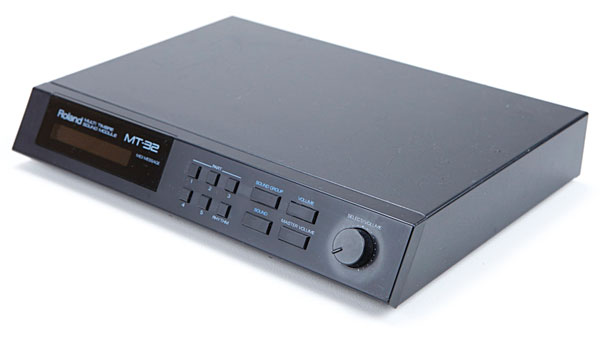

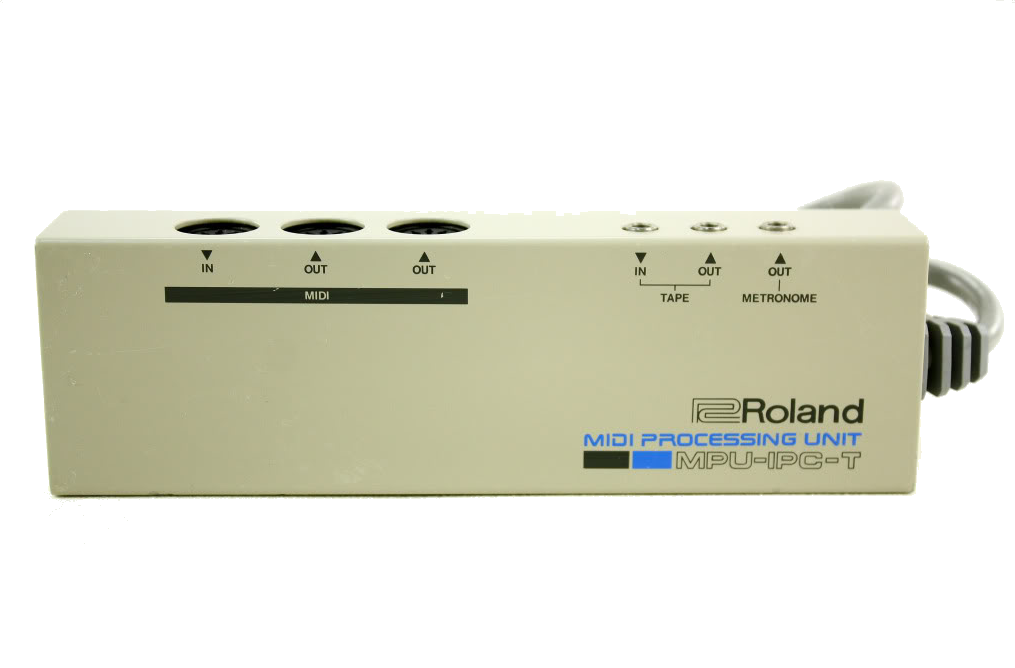
From left to right: a Roland MT-32 synthesizer, an interface card,
and an MPU-IPC MIDI Connector Box.
Hardware
Dusko's new gear is in excellent condition. In 2019 he bought a Roland PC Desktop Music Studio that included an MT-32 and MIDI Connector Box, but the interface card was missing from the set. It also included manuals and flyers. He used a HardMPU card (see bottom of page for more info) as a substitute until recently, when he managed to get hold of a Roland MPU-IPC interface card.
Roland MT-32 "Old"
His MT-32 is what Phil (@ Phil's Computer Lab) refers to as an MT-32 "Old" ('Revision 0' in Roland parlance) - this was the original model that did not come with a headphone audio jack on the rear. It was followed with the MT-32 "New" ('Revision 1') about 1.5 years later. Roland fixed some issues with the MT-32 "New" which sadly broke 100% compatibility with some games that worked around some of the shortcomings of the MT-32 "Old". This means there are audible differences if you run some games that were written expecting an MT-32 "New" on the MT-32 "Old" (and vice versa).
Dusko's MT-32 came in the form of this bundle, called the PC Desk Top Music Studio. As mentioned, the MPU-IPC and Ease Songmaker software (a MIDI music editor and playback application) were missing.
There isn't any indication of when this bundle was released - it came with a flyer advertising the Roland SCC-1 which came out in 1992, but we have some doubts that this was part of the box set seen here. The SCC-1 was basically the same as the Roland SC-55 General MIDI synthesizer on a PC expansion card, and came out in 1992.
So now Dusko has the complete kit. The Ease Musicmaker software is readily downloadable from the internet, and we'll check that out later.
.jpg)
.jpg)
Dusko's MT-32 is an "Old" (Revision 0) one, without the headphone jack on the rear.
.jpg)
The inside of Dusko's MT-32, with its socketed Intel 8095 microprocessor (far right),
PCM ROM (middle-top), reverb ROM (lower left) and two control ROMs (middle-right). The BOSS chip is the reverb processor, the Roland QFP in the centre is the LA32 processor, and the one in the bottom-right is the gate array.
The earliest MT-32 "Old" versions had socketed control/reverb ROMs and the LA32 processor as a PGA chip, like mine here shown for comparison:
.jpg)
My MT-32 "Old", serial no. 831678 with control ROM v1.0.6
and reverb ROM v2.0.0
Interface Card and MIDI Connector Box
Since the MT-32 was designed to work with a multitude of computers, the interface card came in numerous versions, one for each type of computer that the MT-32 was designed to work with, including Apple II, Commodore 64, Sharp C1, NEC PC-88 and PC-98, MSX, Fujitsu FM7 and of course, IBM PC.
The first MT-32s came with a lot of the interface logic on a board inside the MIDI Connector Box and a very simple interface card which was called the MIF-IPC. An updated version of this, MIF-IPC-A, was introduced for AT computers after they discovered some issues running the MIF-IPC on faster PCs.
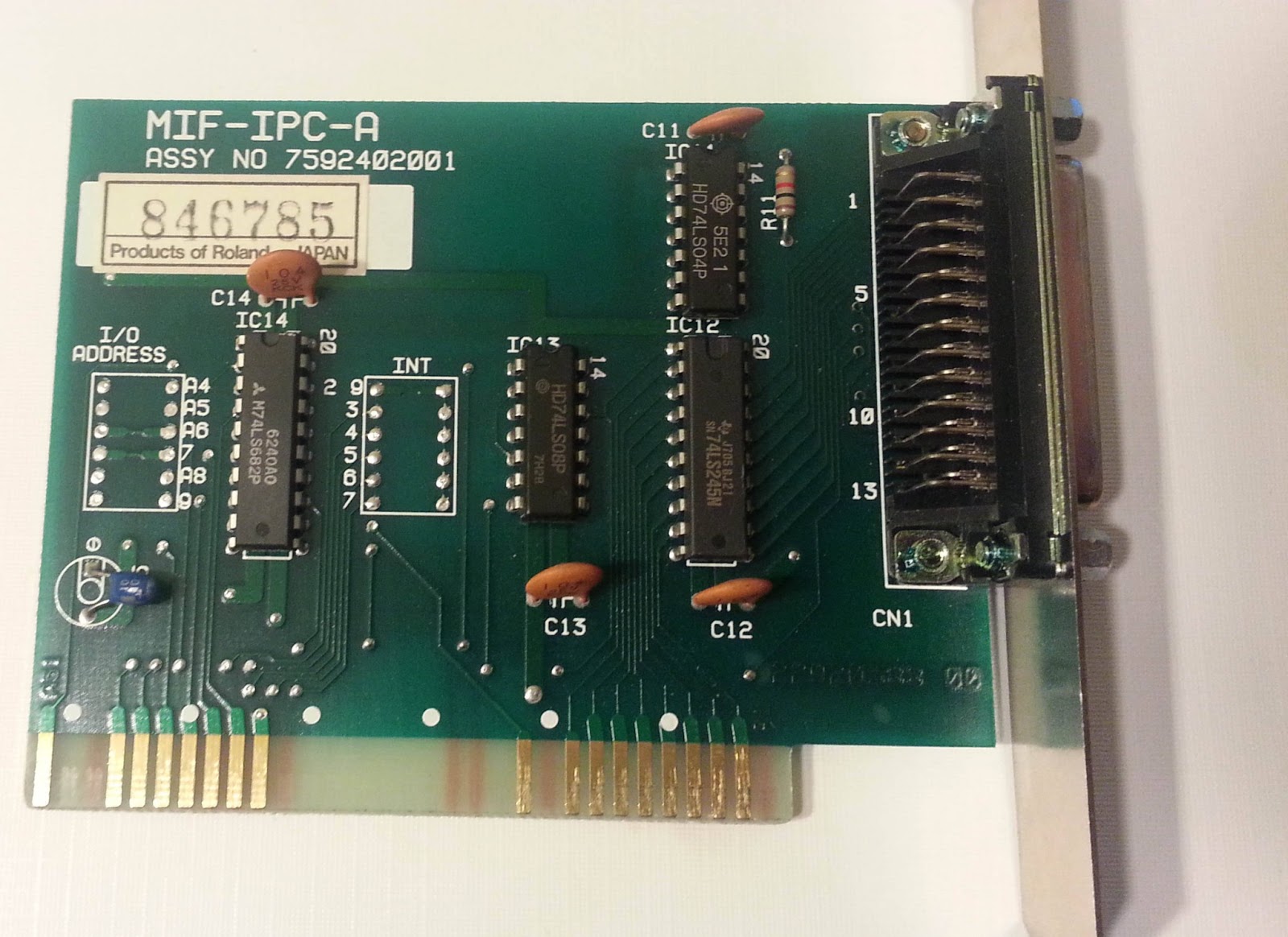
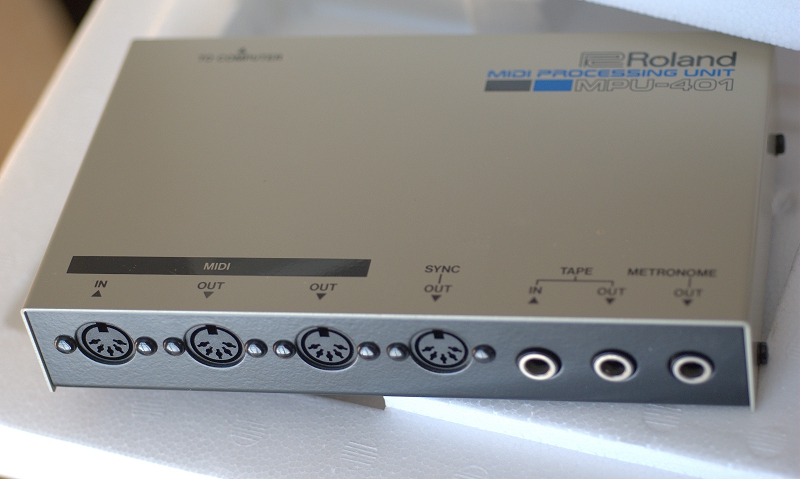
The early interface hardware: MIF-IPC-A interface card and MPU-401 MIDI Connector Box
The hardware was changed in 1988, with more of the interfacing logic on the card, now called MPU-IPC, and the connector box was just used to house the array of audio connections. This is what Dusko has:
.png) |
.png) .png) |
.png)
.png)
Dusko's MPU-IPC card and the smaller, simpler MIDI Connector Box
For Dusko's PC to communicate with the MT-32, the MPU-IPC card is installed in the PC and connected to the MIDI Connector Box.
The first MT-32 games communicated with the MT-32 in what Roland called "Normal" mode, also commonly called "Intelligent" mode. Later MT-32 games used the simpler communication via a sound card's UART (Universal Asynchronous Receiver/Transmitter) chip, so it's called "UART" mode. The latter requires nothing more than a game port/MIDI cable to connect your sound card directly to the MT-32, whereas for Intelligent mode you need an interface card like the MPU-IPC and MIDI Connector box. There is no obvious year when games transitioned to using UART mode, so use my MT-32 game compatibility page to find out.
The MPU-IPC card is hard-wired to use port 330h and IRQ2 (or IRQ9 on AT systems). A variant of the MPU-IPC, the MPU-IPC-T, included these jumpers, and is identical in every other way, which suggests it is feasible to solder some pins to the pads on the MPU-IPC and install jumpers if you want to make these adjustable. I've not tried this so this is just a guess on my part.
Note also that the MPU-IPC connector box cable here shows 20 of the 25 available pins on the connector, which is normal. The MPU-IPC-T variant's cable only had 9 pins. One of the reasons for this is that the MPU-IPC had an additional SYNC OUT DIN socket (the leftmost one in the picture above) which synchronises with the MIDI clock when working with rhythm machines. For retro PC gaming this is not required - the only DIN socket you will use is MIDI IN.
Documentation
Dusko has kindly scanned-in all the documentation that came with his MT-32 kit, which you can read here:
Modern Alternatives
If you're not inclined to have a real MT-32 setup or can't find all the parts you need, there are numerous alternatives at your disposal. Some of these are entirely software-based to emulate an MT-32 like the Munt emulator alongside certain versions of DOSBox and SCUMMVM that support it. If you have a real Roland MT-32 but no interface card or breakout box, and want to run Intelligent mode games, SoftMPU is a utility that captures MIDI messages and emulates Intelligent mode in software:
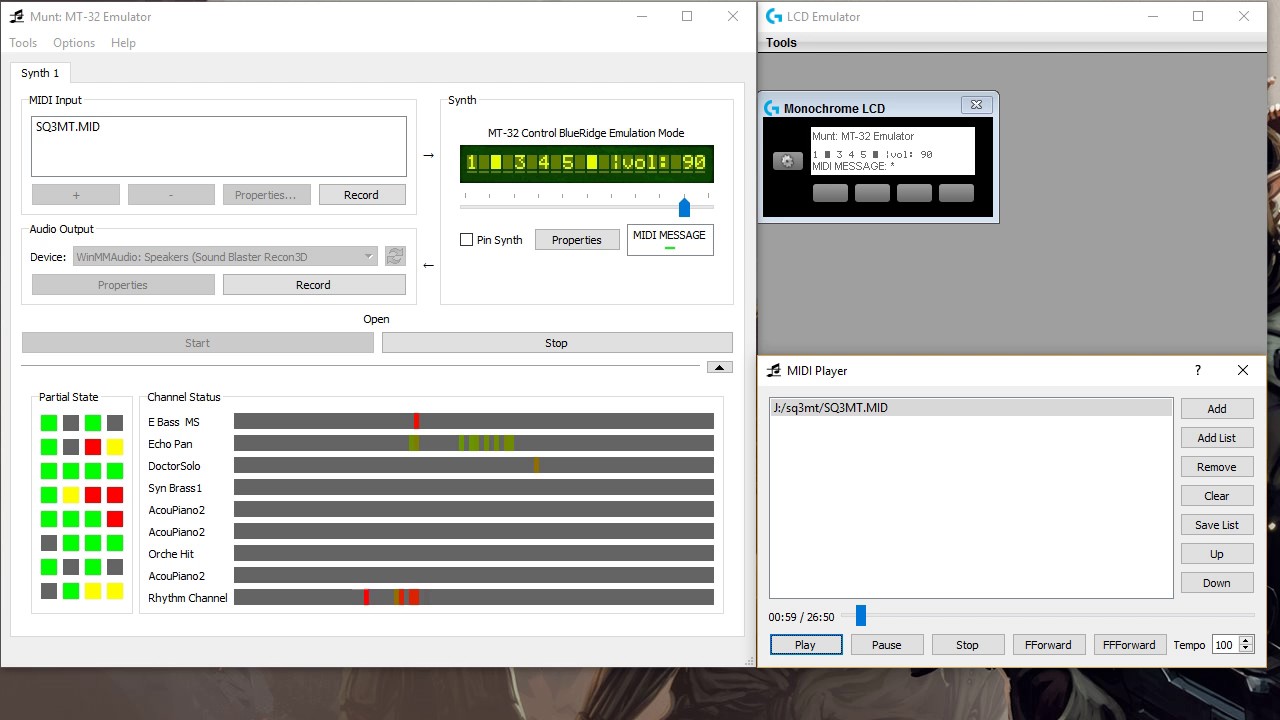
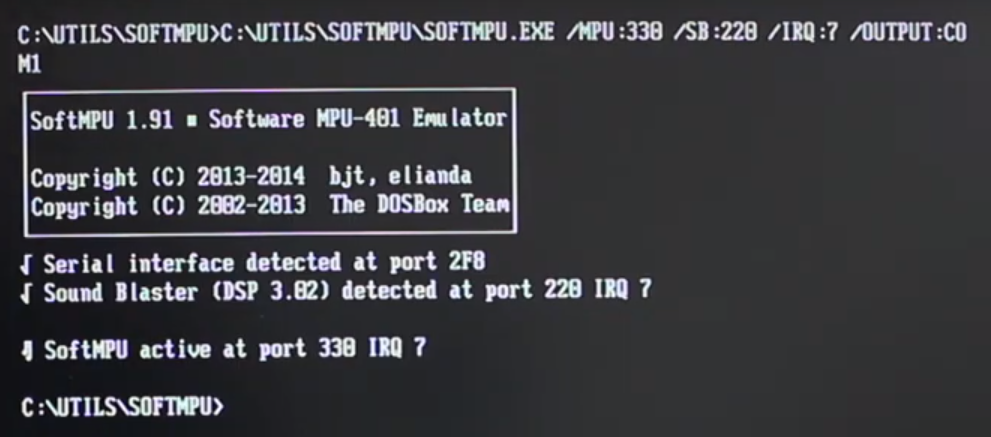
Munt (left) and SoftMPU (right)
SoftMPU works really well, but does require EMM386 to be loaded which may be a blocker for some games. My compatibility list shows that about 46% of intelligent mode games work with SoftMPU.
On the hardware side you have the mt32-pi that provides full MT-32 emulation without the need for any other hardware. Other hardware bits still rely on you having a real MT-32 but provide intelligent mode (basically replacing the interface card and breakout box), like the HardMPU and PCMIDI. Being 8-bit cards, these work on the original IBM PC and up, and also have the added benefit of a wavetable connector so you can install a wavetable daughterboard if you have one!
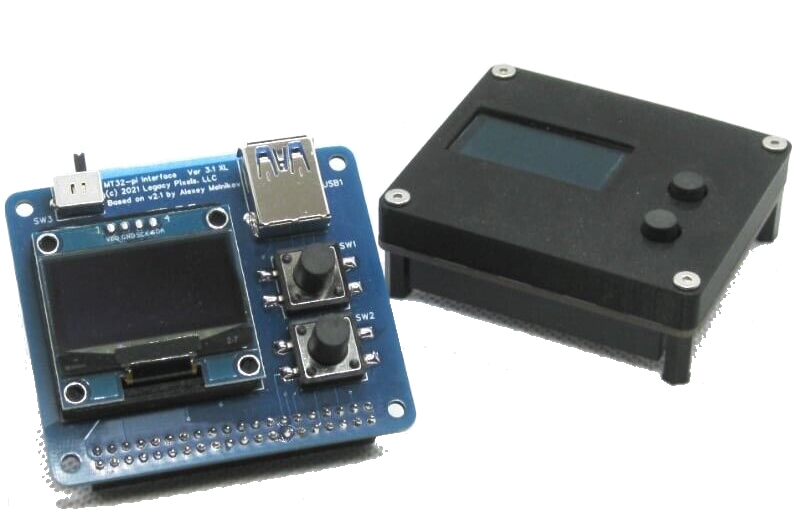
.png)
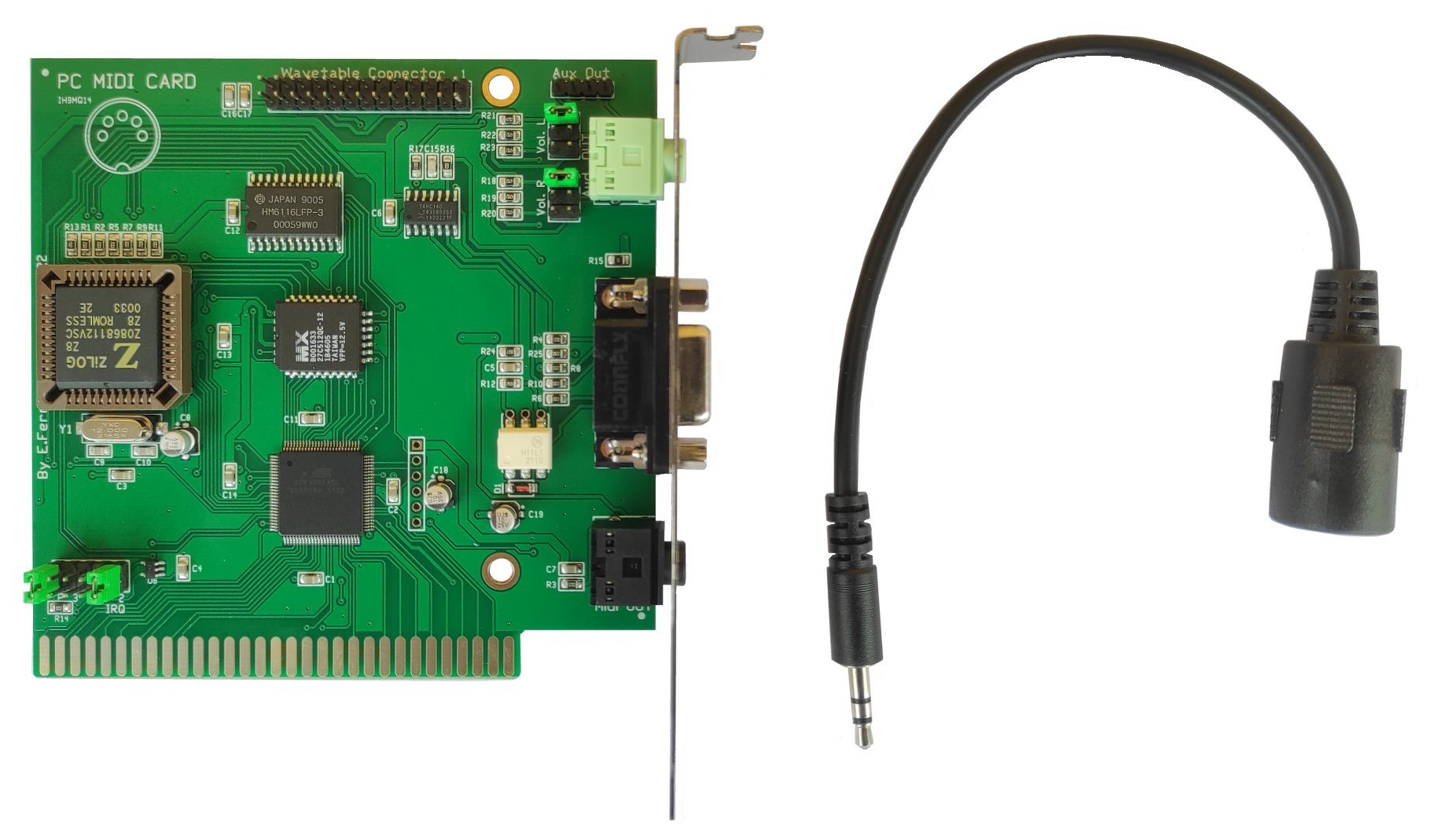
mt32-pi (left) emulates an MT-32 fully for use with DOSBox, SCUMMVM, etc.
HardMPU (right) and PCMIDI (bottom) are modern-day replicas of the MPU-IPC card and breakout box, providing an Intelligent mode interface for direct connection to a real MT-32
HardMPU.png)
The HardMPU card has these features:
Versions 1.1 and 2.0:
- IRQ driven intelligent mode- and UART mode-compatible
- Selectable IRQ and port via jumpers
- JTAG, ISP, and UART interfaces for user expansion
- Wavetable Header (+ audio out connector)
- MIDI output can be switched between the external connector and the wavetable header by software.
Config Utility (hardmpu.com):
- SysEx delay for Roland MT-32 on faster computers
- "Fake all notes off" for Roland RA-50
It does, however, have some limitations:
- Playback only, recording planned but not yet implemented
- Requires an ISA slot in your computer
You can find more information on HardMPU on the Vogons forum.
.jpg)
.jpg)
.jpg)
.jpg)
.jpg)

.png)